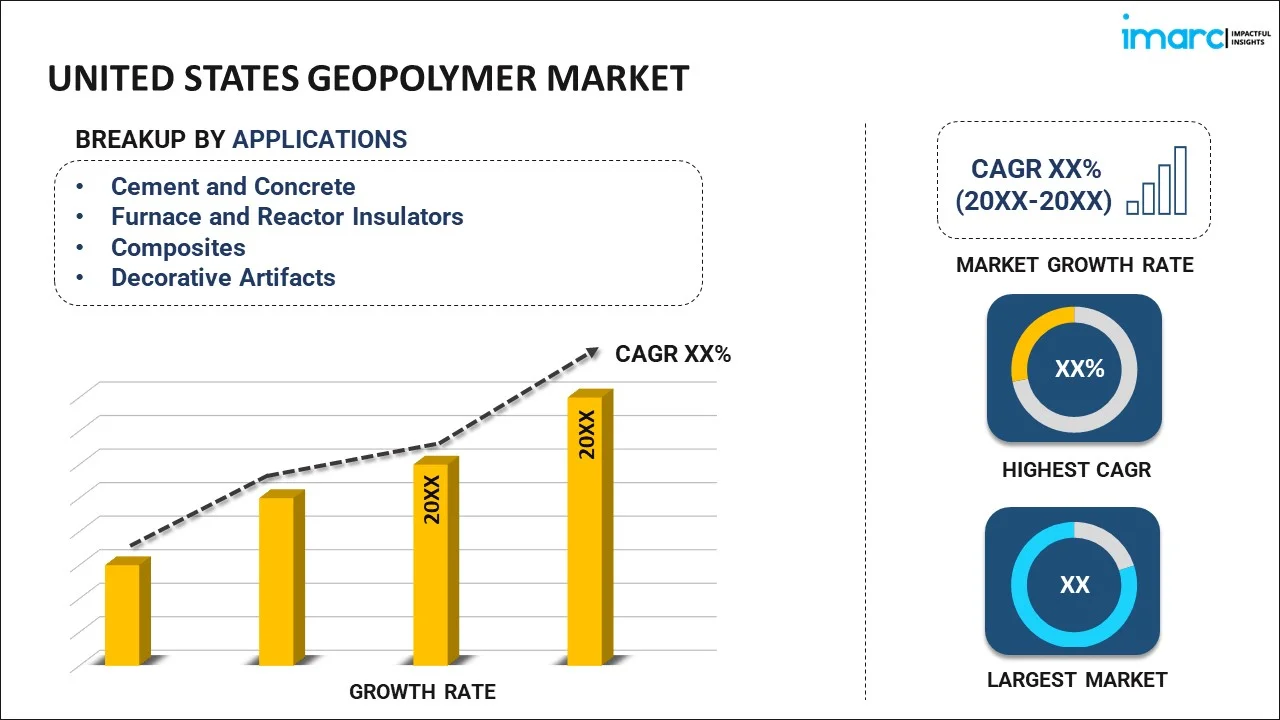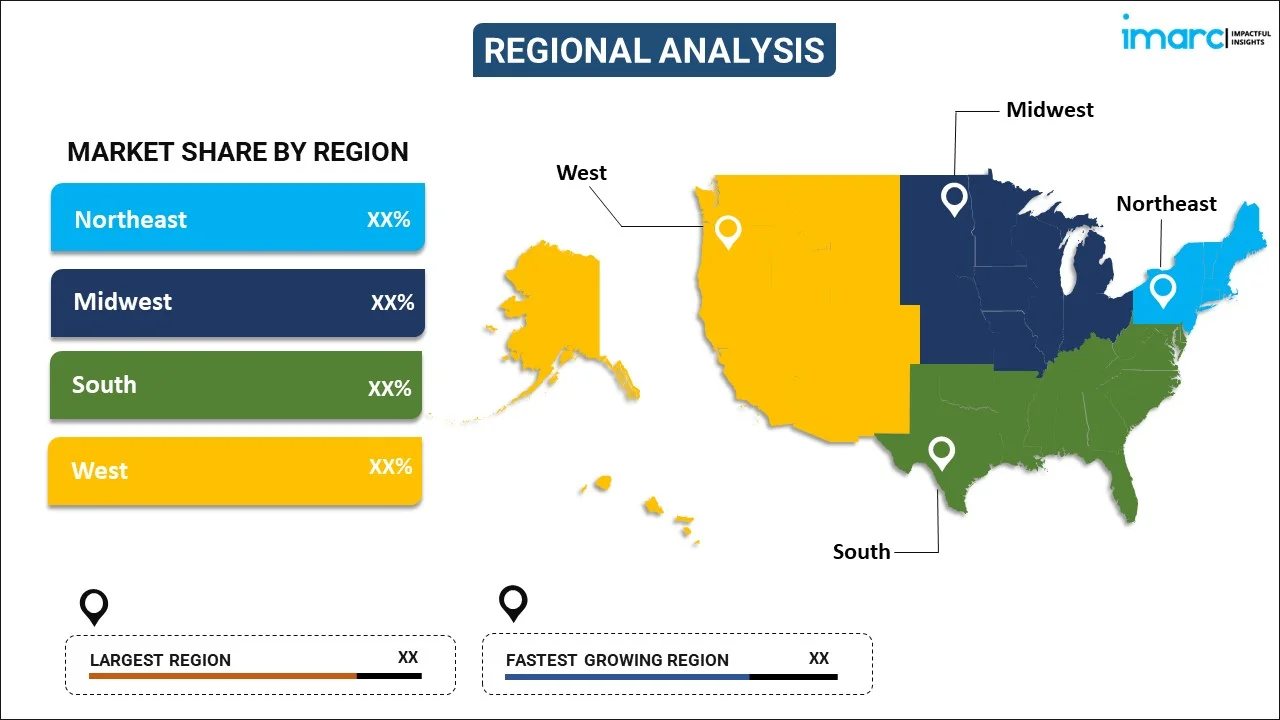
United States Geopolymer Market Report by Application (Cement and Concrete, Furnace and Reactor Insulators, Composites, Decorative Artifacts), End Use Industry (Building Construction, Infrastructure, Industrial, Art and Decoration, and Others), and Region 2025-2033
Market Overview:
The United States geopolymer market size reached USD 728.5 Million in 2024. Looking forward, IMARC Group expects the market to reach USD 5,948.0 Million by 2033, exhibiting a growth rate (CAGR) of 24.96% during 2025-2033.
|
Report Attribute
|
Key Statistics
|
|---|---|
|
Base Year
|
2024
|
|
Forecast Years
|
2025-2033
|
|
Historical Years
|
2019-2024
|
|
Market Size in 2024
|
USD 728.5 Million |
|
Market Forecast in 2033
|
USD 5,948.0 Million |
| Market Growth Rate 2025-2033 | 24.96% |
United States Geopolymer Market Insights:
- Major Market Drivers: Heightened focus on sustainable building, with green regulations and carbon emissions reduction targets, is stimulating demand for geopolymers. Their potential to use industrial by-products such as fly ash and slag to form geopolymers makes them suitable for green infrastructure development throughout the United States.
- Key Market Trends: Advanced geopolymer compositions are becoming popular in fire-resistant, high-temperature, and structural uses. The emergent applications of geopolymers in defense, aerospace, and industrial insulation point toward an inclination toward tough, heat-resistant, and environmentally sustainable materials compared to traditional construction and composite materials.
- Competitive Landscape: Local manufacturers are investing in domestic technologies and regional value chains in order to address increased demand. Strategic collaborations with research facilities are boosting innovation, allowing companies to customize geopolymer solutions for varied uses, enhance product performance, and diminish import dependency.
- Challenges and Opportunities: In spite of limited commercial experience and standardization impediments, firm government support and sustainability requirements present enormous growth opportunities. Educational efforts, pilot work, and linkage with green infrastructure programs are opening doors for geopolymers to grow in the conventional construction and industry.
Geopolymers refer to inorganic ceramic materials synthesized by combining source materials that are rich in silica and alumina. Sodium hydroxide-based geopolymers are found to be more crystalline and stable, whereas geopolymers made with the sodium silicate activator are amorphous and less stable in an acidic medium. They are utilized for medicinal purposes, in fire and heat resistant coatings and adhesives, high-temperature ceramics, and toxic and radioactive waste encapsulations. In the United States, the demand for geopolymers has escalated as they provide numerous advantages like high strength, ultra-porosity, low drying shrinkage, low creep, and acid resistance.
The United States geopolymer market is primarily driven by rising construction, manufacturing, and mining activities. They are also used in various fields like modern inorganic chemistry, mineralogy, physical chemistry, geology, and colloid chemistry. Furthermore, with the growing environmental regulations and emission strain on the cement industry, geopolymers are widely utilized as a substitute for Portland cement for the construction of bridges, tunnels, roads, and other civil infrastructure in the region. Furthermore, factors such as technological developments and innovations in the construction sector and the increasing capital investments made by the major players are positively impacting the market in the United States.
United States Geopolymer Market Trends:
Increased Demand for Green Building Materials
Increased focus on green infrastructure is driving the use of geopolymers in the US building industry. The materials, which have a lower carbon footprint than traditional Portland cement, are more widely used in green buildings and public works. As per the sources, in September 2024, C-Crete Technologies cast the world's first granite-based concrete, Portland cement-free and CO₂ emissions-free, providing over 5,000 psi strength, ASTM acceptance, and complete cost-performance equivalence. Moreover, government policies promoting the use of low-emission substitutes also support demand. Geopolymers are becoming successful in precast components, bricks, and pavement structures because of their strength and thermal resistance. This new trend towards sustainability is creating a long-term transformation in the choice of building materials. United States geopolymer market trends suggest that this sector will continue to be critical in meeting national sustainability goals. With ongoing development of technology in material composition and higher research grants, the sector is anticipated to grow consistently. With environmental responsibility emerging as a prime condition for procurement, the United States geopolymer market is ready to gain hugely from such a green revolution.
Infrastructure Modernization Drives Adoption
United States investments in infrastructure renewal are building solid tailwinds for geopolymer uses across the nation. As long-term plans for infrastructure improvement are made, various civil engineering uses like the road network, bridges, and water management infrastructure are looking to geopolymers due to their excellent chemical resistance and lifecycle longevity. These inorganic polymers endure aggressively hostile environmental conditions excellently, and that makes them highly suitable for large-scale operations. Public authorities are increasingly undertaking pilot projects and field tests for geopolymer-based concrete and composites, solidifying their prospects for extensive implementation. United States geopolymer market analysis indicates a causal relationship between material innovation and infrastructure allocation. Also, geopolymers enable circular economy through the utilization of by-products of industry like fly ash and slag. Not only does this minimize waste, but it also saves raw material expenses. Subsequently, United States geopolymer market size is anticipated to expand as government-supported initiatives seek cost-efficient and performance-effective options over conventional materials.
Development in Fire-Resistant Applications
The heat-resistance properties of geopolymers are opening up new areas of growth in specialized industries like aerospace, defense, and industrial production. These industries are increasingly using geopolymer compositions for thermal insulation, fire protection, and high-temperature coating. Geopolymers provide better structural integrity upon exposure to high temperatures compared to organic polymers, which is essential for safety-critical applications. Their application in refractory linings and protective enclosures is increasing, especially in plants with demanding fire safety needs. Advances in composite integration and reinforcement by fibers are continually improving mechanical properties. Based on existing United States geopolymer market development trends, the application of advanced geopolymer composites is likely to increase with the changing safety standards. As the world of material science advances to newer technologies and applications, United States geopolymer market share in high-temperature segments will grow. This movement is an extension of the larger trend of bringing cutting-edge materials into performance-critical industries.
Key Market Segmentation:
IMARC Group provides an analysis of the key trends in each sub-segment of the United States geopolymer market report, along with forecasts at the country and regional level from 2025-2033. Our report has categorized the market based on application and end use industry.
Breakup by Application:

To get more information on this market, Request Sample
- Cement and Concrete
- Furnace and Reactor Insulators
- Composites
- Decorative Artifacts
Breakup by End Use Industry:
- Building Construction
- Infrastructure
- Industrial
- Art and Decoration
- Others
Breakup by Region:

- Northeast
- Midwest
- South
- West
Competitive Landscape:
The competitive landscape of the industry has also been examined along with the profiles of the key players.
Latest News and Developments:
- July 2024 – Geopolymer Solutions, a Conroe, Texas-based company, introduced FP250, a high-strength geopolymer material for wastewater treatment plants. The product provides increased durability, chemical resistance, and lower maintenance, meeting sustainability objectives and enabling infrastructure resilience with increased low-carbon construction material demand throughout the United States.
Report Coverage:
| Report Features | Details |
|---|---|
| Base Year of the Analysis | 2024 |
| Historical Period | 2019-2024 |
| Forecast Period | 2025-2033 |
| Units | Million USD |
| Segment Coverage | Application, End-Use Industry, Region |
| Region Covered | Northeast, Midwest, South, West |
| Customization Scope | 10% Free Customization |
| Post-Sale Analyst Support | 10-12 Weeks |
| Delivery Format | PDF and Excel through Email (We can also provide the editable version of the report in PPT/Word format on special request) |
Key Questions Answered in This Report
The geopolymer market in the United States was valued at USD 728.5 Million in 2024.
The United States geopolymer market is projected to exhibit a CAGR of 24.96% during 2025-2033, reaching a value of USD 5,948.0 Million by 2033.
Key drivers of the United States geopolymer market are increased demand for low-carbon and sustainable building materials, government incentives for green infrastructure, and heightened awareness of environmental costs associated with conventional Portland cement. A further advancement in geopolymer technology, readily available industrial by-products such as fly ash and slag, and strict emission standards are driving market acceptance across commercial and public infrastructure developments.
Need more help?
- Speak to our experienced analysts for insights on the current market scenarios.
- Include additional segments and countries to customize the report as per your requirement.
- Gain an unparalleled competitive advantage in your domain by understanding how to utilize the report and positively impacting your operations and revenue.
- For further assistance, please connect with our analysts.
 Request Customization
Request Customization
 Speak to an Analyst
Speak to an Analyst
 Request Brochure
Request Brochure
 Inquire Before Buying
Inquire Before Buying




.webp)




.webp)












